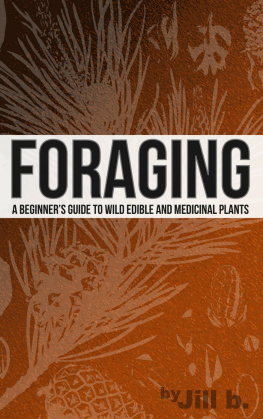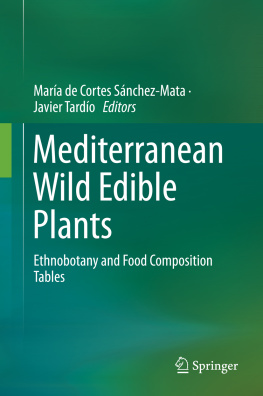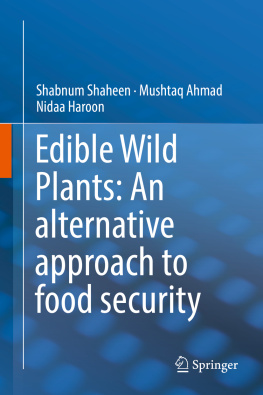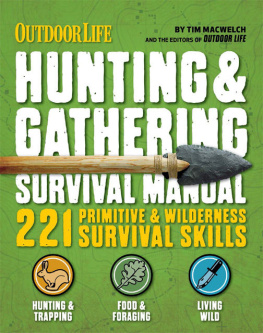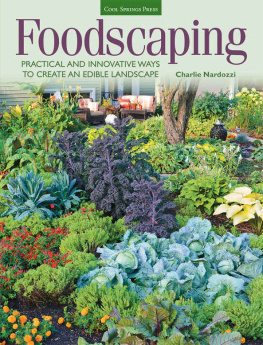The U.S. Navy SEAL
Guide to
Food and Hunting Secrets
Learn the survival techniques and
strategies of americas
elite warriors
Don Mann
and Ralph Pezzullo
Skyhorse Publishing

Since food ranks third on the basic survival skills priorities list, dont worry about looking for food until you have a good water source and adequate shelter.
Although you can live three weeks or so without food, youll need an adequate amount to stay healthy. Without food, your mental and physical capabilities will deteriorate and youll become weak. Food replenishes the substances that your body burns and provides energy, vitamins, minerals, salts, and other elements essential to good health.
The average person needs approximately 2,000 calories per day to function at a minimum level. To varying degrees both plants and animals (including fish) will provide the calories, carbohydrates, fats, and proteins needed for normal daily body functions.
Most natural environments are filled with a variety of items that can meet our nutritional needs. Wild plants often provide the most readily available foods, though insects and small wild game can also support dietary needs in a survival situation.
Meat and fish are good sources of protein and fat and provide virtually everything a long-term survivor would need. However, at the first stage of a survival situation, edible plants are the most appropriate diet as plants are easily accessible and contain the necessary carbohydrates.
In a survival situation, take advantage of the food sources available. Try to vary your diet to make sure you get the appropriate proportions of fat, protein, carbohydrates, minerals, and vitamins.
Seek the more abundant and more easily obtained wildlife, such as insects, crustaceans, mollusks, fish, and reptiles, while you are preparing traps and snares for larger game.
Basic Food Survival Rules:
1.If it walks, crawls, swims, or flies, it is most likely safe to eat and will provide the nutrition and energy your body requires.
2.ALL fur-bearing mammals are safe to eat and will provide you with nutrients and calories.
3.ALL six-legged insects are safe to eat and will provide you with nutrients and calories.
4.DO NOT eat spiders.
5.Almost all freshwater fish and birds are safe to eat and will provide you with nutrients and calories.
6.Use EXTREME CAUTION with plants. Dont eat them unless you know theyre safe.
7.DO NOT eat mushrooms, unless you are absolutely certain it is nontoxic , or any plant that has a milky sap.
Food Tips
A single emergency food bar can contain up to 3,600 calories and is designed to provide enough nutrition to last up to three days. Stash a few of these in your E&E kit, your second line gear, or in your go-bag.
Also easy to carry and useful are beef and chicken bouillon cubes. On a cold night out in the wild, a cup of hot broth will warm you up nicely.
Hard candy, e.g.., Jolly Ranchers, offers a quick hit of sugar, which can be very helpful.
Edible Insects
Most insects are rich in protein and fat, the two most vital nutritional needs for survival. Ants, grubs, grasshoppers, dragonflies, worms, and centipedes are edible.
Some arent the most appetizing and some taste pretty good. A good way to get over your natural resistance to eating insects is to dry them by the fire and add them to whatever you cook. I recommend that all insects be boiled or roasted to kill parasites.
Insects with bright colors should be avoided, as they might be toxic.
Any of the creatures listed below, once cooked, can be served with soy sauce or salt or mixed into a stir-fry or stew made of plants.
Grasshoppers
According to entomologists, a single large grasshopper is comprised of sixty percent protein and 6.1 grams of fat. Eating a handful of them roasted (not raw) is nearly the equivalent of consuming a hamburger. Crickets are second best. Remove the legs and wings, then roast them on a rock slab in the center of your fire for twenty minutes until crispy. Boiling for five minutes is another good way of cooking them. To catch them in the wild, use a three-foot section from a flexible, green willow shoot and swat them like you would a fly.
Ants
Boil the pupae (whitish eggs found in the nest) to make a hearty stew. The best way to collect pupae in large numbers is by carefully digging into the top layer of an anthill during the early morning. Make sure to avoid fire-ant mounds! One or two scrapes off a small section of the hill should expose the egg chamber. After collecting the eggs, cover the mound back up with dirt so the colony can recover.
Grubs, larva, worms
Earthworms can be dried like jerky and added to stew. Also, grubs found under or in rotten logs are relatively easy to collect, and can be added to a stew. Grubs, worms, and larva can also serve as excellent fishing bait.
Plants
Plants, roots, and green vegetables can provide carbohydrates and enough protein to keep the body functioning at normal efficiency, even in the arctic. Nuts and seeds are also an excellent source of proteins and natural oils.
Edible Plants
Be careful and dont eat any plant that youre not sure is safe. Some plants will poison you on contact, ingestion, or by absorption or inhalation. Also, many edible plants have deadly relatives and look-alikes.
As a general rule, before you head out into the wild, know at least three edible plants in the area that you are traveling. Learn them by their leaves, stalks/stems, and roots, as all three are part of the plant, might have use, and will confirm identity of the plants. Take into account the seasons when they grow and soils where they grow, and any relative plants that are around that might lead you to them.
I also recommend knowing at least three plants that are medicinal in some significant way and that are easily identified, readily available, and most useful based on your needs.
Common edible plants include cattail roots, acorns, clover, dandelions, almost all grasses that are seed bearing, and the inner bark of trees such as poplar, willows, birches, and conifers.
Common and Abundant Plant Food Sources in North America
A manzanita bush is a great food source in the wild. The Mono Indians used them for their fruit, which they dried or used for drinks. If you come across the bush, chew the outer bit of the fruit, then spit out the hard seeds. The fruit is high in vitamin C.
Cattails are known as the supermarket of the swamp. No matter the season, there are always edible parts available on the cattail plant. The roots, shoots, and pollen heads can all be eaten.
The inner bark of conifer trees , known as the cambium layer, is full of sugars, starches, and calories. It can be eaten on most evergreen, cone-bearing trees except for yews, which are all poisonous and are identified by red berries. The inner bark should be scraped out and cooked to convert the fibers into a more digestible form.
All grasses are edible. The leaves can be chewed and the juices swallowedthough be sure to spit out any indigestible fibers.
All acorns the nuts produced by oak trees can be leached of their bitter tannic acids and eaten, providing an excellent source of protein, fats, and calories. To rid the acorns of tannins, place them in a net bag in a stream for a day, or put them into several changes of boiling water. White oaks have the least amount of tannins and therefore the best flavor.
Again, be sure to properly identify any plant you plan on consuming. Many plants can be difficult to identify and some edible plants have deadly poisonous look-alikes. If you cannot identify the plant, DO NOT eat it.


